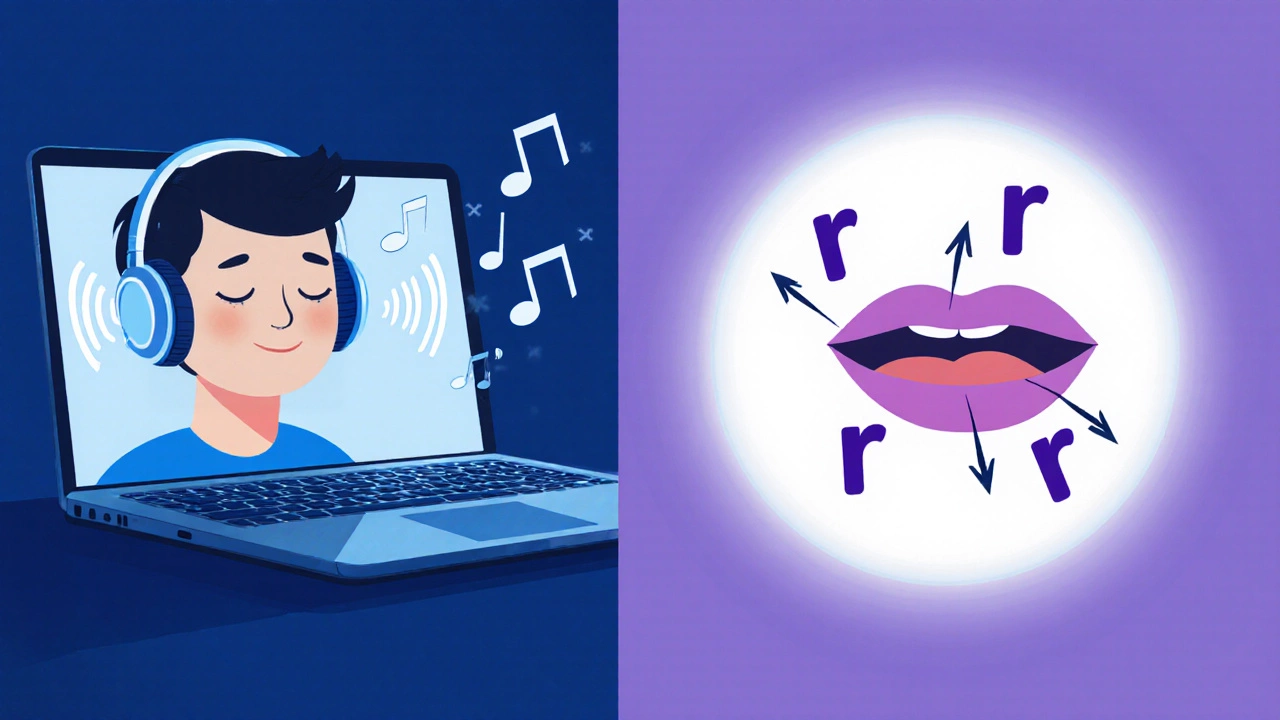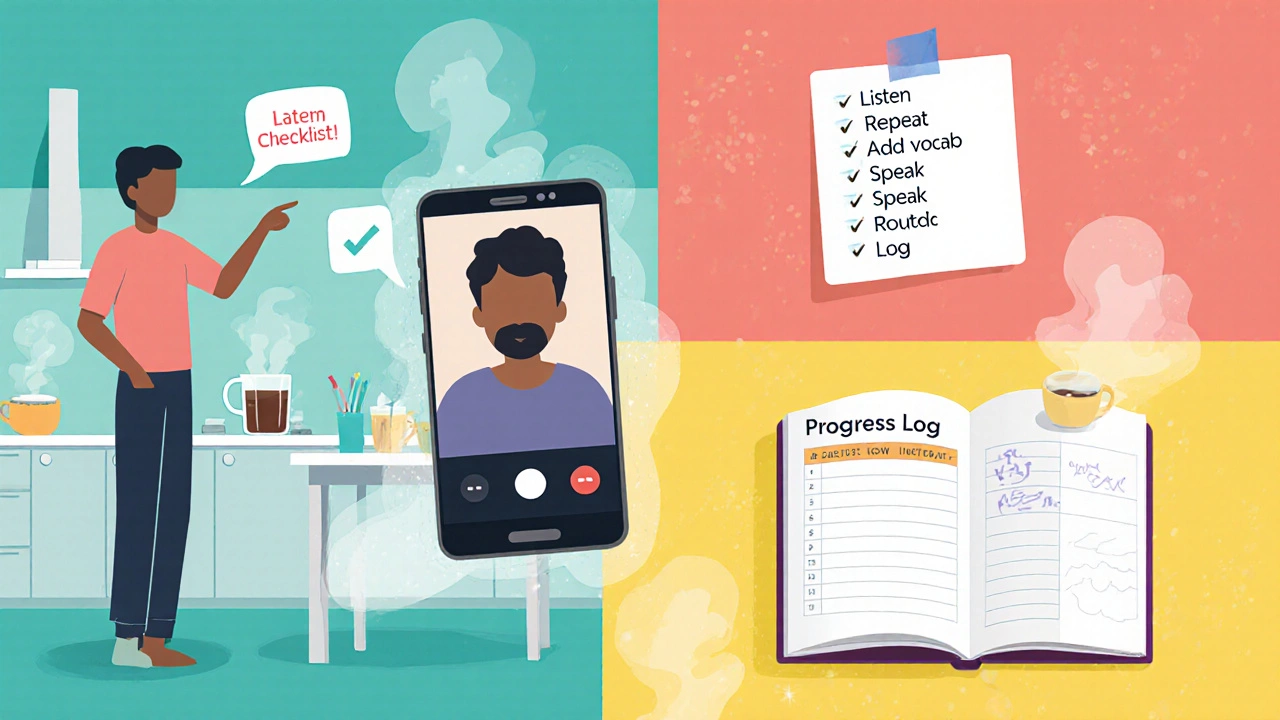Self‑Study Guide: How to Teach Yourself to Speak English
 Oct, 10 2025
Oct, 10 2025
English Speaking Goal Tracker
Short-Term Goal
Example: "Order food in English without hesitation"
Long-Term Goal
Example: "Lead a project meeting in English"
Your Progress
Weekly Progress Log
No progress logged yet. Start by saving your first entry!
Want to actually start talking in English instead of just memorising grammar? You can do it, and you don’t need a classroom or a pricey tutor. This guide shows you step‑by‑step how to teach yourself English speaking and keep the momentum going for months and years.
Set Clear, Bite‑Size Goals
Before you dive in, decide what “speaking English” looks like for you. Is it ordering coffee in a UK café, holding a 15‑minute video call with a colleague, or giving a 5‑minute presentation at a conference? Write down one short‑term goal (e.g., “order food in English without hesitation”) and one long‑term goal (e.g., “lead a project meeting in English”). Goals give you a target to measure progress against and prevent you from drifting into endless theory.
Lay the Foundation with Listening and Pronunciation
English language is a global lingua‑favored tool for business, travel, and culture, spoken by over 1.5billion people worldwide. Its rhythm, stress patterns, and vowel reductions can feel foreign to non‑native ears.
Start each day with 10‑15 minutes of focused listening. Pick one podcast or YouTube channel that matches your level and play it at normal speed. Write down three phrases that stick, then repeat them aloud, mimicking intonation exactly. This “shadow‑learning” technique trains both auditory discrimination and muscle memory for pronunciation.
Pronunciation practice is the bridge between hearing a word and producing it clearly. Use a free app that shows you the mouth shape (e.g., the phoneme view in Forvo). Record your voice, compare it to a native speaker, and adjust. Do this for at least five tricky sounds each week - think the “th” in “think” or the “r” in “right”.
Build Vocabulary That Gets You Talking
Vocabulary building is most effective when the words are tied to real situations. Instead of memorising isolated lists, create “topic cards” - a small stack for each everyday scenario (shopping, travel, work). On a card, write the English phrase on one side and a personal cue on the other (e.g., a picture of a coffee cup for “Can I have a latte, please?”). Review the stack daily, swapping cards as you become comfortable.
Use spaced‑repetition software (SRS) like Anki, but keep the decks tiny - 20‑30 cards per topic. Over‑loading the system kills motivation. Pair each new word with a sentence you actually plan to say, then practice that sentence out loud.

Find Real Speaking Opportunities
Conversation partner is the most valuable resource you can have. Platforms such as Tandem or Speaky let you match with native speakers who want to learn your language. Schedule a 20‑minute video call once or twice a week, and treat it like a mini‑class: prepare three topics in advance, write down useful phrases, and ask for corrective feedback.
If a live partner feels intimidating, start with “language immersion” at home. Change the subtitles on your favourite series to English, set your phone’s interface language to English, and narrate daily chores aloud (“I’m washing the dishes now”). The brain starts treating English as the default mode of expression.
Another low‑pressure approach is “talking to yourself”. Pick a daily routine-making coffee, commuting, or exercising-and describe each action in English as you do it. Over time, you’ll notice a smoother flow and fewer pauses.
Leverage Technology for Structured Practice
Below is a quick comparison of the most popular free and paid platforms for self‑guided English speaking practice. Choose one that matches your budget and learning style.
| Tool | Cost | Key Feature for Speaking | Best For |
|---|---|---|---|
| Duolingo | Free (ads) / $12.99/mo | Spoken exercises with instant feedback | Beginners who like gamified lessons |
| italki | $15‑$30/hour (tutor fee) | One‑on‑one video sessions | Learners who want personalised correction |
| Elsa Speak | Free / $9.99/mo | AI‑driven pronunciation scoring | Pronunciation‑focused users |
| Speaky | Free | Live language exchange with text/voice chat | Social learners who enjoy informal practice |
| Rosetta Stone | $179/yr | Immersive speech‑recognition lessons | Intermediate learners seeking structured curriculum |
Track Progress and Keep Motivation High
Use a simple weekly log: date, activity (e.g., “watched 30min BBC News”), new phrase, and self‑rating (1‑5) on speaking confidence. Review the log every Sunday and note improvements. Seeing a row of “3 → 5” scores is a powerful motivator.
If you hit a plateau, change the input source: switch from American podcasts to British news, or from sitcoms to TED talks. Fresh accents force your brain to adapt and often re‑ignite curiosity.

Quick Checklist for Daily Self‑Study
- Listen to native audio for at least 10minutes.
- Repeat 5 new phrases using shadow‑learning.
- Add 2‑3 vocabulary cards to a topic deck.
- Speak aloud about a daily routine for 3minutes.
- Log your activity and confidence rating.
Common Pitfalls and How to Avoid Them
Language immersion can backfire if you drown in content that’s too advanced. Keep the difficulty just above your current level (the “Goldilocks zone”).
Don’t rely solely on vocabulary flashcards. Speaking forces you to retrieve words in context, which is the ultimate test of retention.
Avoid the perfection trap; native speakers appreciate effort, not flawless grammar. Focus on clarity and fluency first, then polish details later.
Frequently Asked Questions
How long does it take to speak English comfortably?
Time varies, but most learners who practice 30‑45minutes daily reach conversational confidence in 4‑6months. Consistency beats intensity.
Do I need a tutor if I’m self‑studying?
A tutor isn’t mandatory, but occasional feedback (via italki or a language‑exchange partner) helps correct entrenched errors early.
What’s the best app for pronunciation?
Elsa Speak provides AI‑driven scoring and bite‑size drills that target individual phonemes, making it a top choice for solo learners.
How can I practice speaking without a partner?
Talk to yourself while doing chores, record monologues, and shadow podcasts. The key is to produce the language out loud, not just in your head.
Should I focus on British or American English?
Pick the accent that matches your goals (e.g., British English for UK work, American English for US media). Consistency matters more than the specific variant.